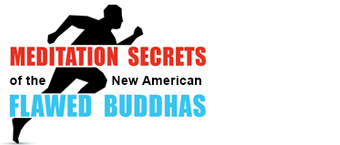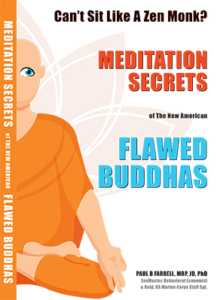Last Updated on March 19, 2021 by Paul Farrell, MRP, JD, PhD

Breath counting… You breathe 16,000 times a day, try “zoning out,” count-down 24 breaths… using a basketball game clock!
“This is a warning: Stress may kill. Literally. (The bodily version thereof.) And it surely kills effectiveness!
Antidote? That’s up to you. A few deep-breathing breaks, or two-minute-eyes-closed meditative stints, can be invaluable during the course of the day.
So, too, a long holiday – and the occasionally four-day weekend. Such breaks are essential …
One more thing, the tougher the circumstance, when breaks are impossible, the more you need a break.”
– Tom Peters, In Search of Excellence
Want a simple way to regain your composure, balance and peace of mind during a tense day, maybe right in the middle of a rough meeting – breathe! Just ten seconds of relaxing breathing will do. Works for me. Don’t make a big fuss about it, just breathe and notice what you’re doing. And since everyone else in the meeting is breathing, the chances are nobody will pay any attention to you.
The key is that you’re not just breathing automatically, you’re taking control of your breathing, and paying attention to how you’re breathing.
Of course, that’s a problem causing stress for most people today – we all breathe, but we’re not really aware of our breathing! And under stress, our breathing slows, lessening our intake of oxygen, lowering our effectiveness while increasing the strain on our physiological and psychological system.
Relaxing Breathing Takes Just Ten Seconds

Do it right now! For 10 Seconds. Breathe in for 5 seconds and out for 5 seconds.
So do it right now, in the middle of the meeting – takes just ten seconds – one deep breath, five seconds on the intake, five on the outtake. And while you’re at it, tell yourself something positive, be grateful. Then take another ten-second breather. And later another. Become aware of your breathing.
And if you want to get mildly dramatic – and make a statement – stand up, walk to a window, stretch your arms way out wide, and silently feel like you’re in control of the meeting. Take a deep breath, slowly. Just ten seconds. Then without comment, sit down, your actions say it all and I’ll bet you’ll even get a positive mental attitude out of the experience.
“If today you can be aware of breathing for ten seconds more than you were yesterday,” says Dr. Andrew Weil in Breathing: The Master Key to Self Healing, “you will have taken a measurable step toward expanded consciousness, deeper communication between mind and body, and integration of your physical, mental, and spiritual functions. I can recommend no single more powerful, or more simple, daily practice to further your health and well-being.”
Try it, what do you have to lose? What do you have to gain!
That’s quite a powerful endorsement of a few extra ten-second breaths a day. Should be enough to get you down to your favorite bookstore. He’s easy to find, you can’t miss seeing the good-natured Doctor Weil with his bushy beard, shiny top, and a friendly “hi there, I hope you’re feeling well” smile.
Breathing Creates “Optimal Health” in Eight Short Weeks
Doctor Weil is an American pioneer in integrative medicine. He’ll help you put your breathing in context as you get healthy. How? By focusing on your whole person, nudging you into a healthy lifestyle of nutrition, physical fitness and meditation.
Grab the good doctor’s best-seller, 8 Weeks to Optimal Health next time you’re in the bookstore. Then buy a cup of tea, sit quietly, relax and flip through the book, there’s a message in it for you. Just remember, the good doctor’s main point is very simple – just for today become aware of your breathing “for ten seconds more than you were yesterday.” And you’re on your way to optimal health.
Breathing Techniques for Stress Reduction
You can increase your awareness and reduce stress with these 5 techniques of breathing in different ways:
- Count each breathe rather than timing them.
- Exhale normally, then squeeze more out.
- Breathe in the mouth, out the nose.
- Breathe rapidly to stimulate, then slow breathing to relax.
- Breathe in the left nostril, out the right.
Remember, just more ten seconds of awareness today than yesterday – and you will increase your awareness of being alive, of breathing, being relaxed, reducing stress and fully occupying your mind and body.
The 24-Second Game Clock Breath Counting Meditation
Here’s an fascinating breath counting meditation for athletes, accountants and others trapped in a world of numbers. You breathe over sixteen thousand times a day – most of the time unaware of this great breathing machine that keeps you alive. Well, here is one way to see if you’re capable of taking full command of your body’s breathing process, by seeing just how long you can count your breathes.
Dr. Wayne Dyer’s “24-second clock method” of breath-counting may seem rather weird at first, but it’s a great way to do a simple meditation technique that’s probably the most time-honored meditation practiced throughout history in both Eastern and Western cultures. Here’s how Dyer does his meditation while counting down the clock from a basketball game:

Visualize an NBA shot clock
“Visualize a clock made of numerous lights outlining the number 24. Then I shift down ‘23.’ My own personal rule at the beginning is to get the clock in my mind to go down from ‘24’ to ‘0,’ seeing each number light up. If at anytime in that interval I become distracted, or a thought pops into my mind for even a fleeting microsecond, I start the clock over at ‘24’ and work it back to ‘0’ without any intervening thought or mental distractions. This is the way of learning to discipline yourself to concentrate on one thing and to empty your mind of all other thoughts. Getting all the way to ‘0’ from ‘24’ is a monumental accomplishment!”
The game-clock version of the basic breath-counting meditation comes from Dr. Dyer’s Real Magic, which is one of my favorite inspirational books and probably the greatest of all his books. You are strongly encouraged to read it while working this meditation for a period of time.
Breath Counting Meditation Vs. Throwing the Elephant
Now if this method sounds too much like more work, stick with Weil’s occasional ten-second deep-breathing, using it inconspicuously in your office and occasionally lengthen your time sitting in meditation by using the light-hearted approach suggested by popular Fortune columnist and CBS executive Stanley Bing in Throwing the Elephant: Zen & The Art of Managing Up.
“Meditation: Step One. Sit down. If you are already sitting, stay that way. Breathe. Breathe again. Breathing is good. Think about the alternative! Your goal is to reach a place where, no matter what happens in any given day, you just don’t give a shit. This is more difficult than one might think. It is in the nature of human beings to care what happens to them. But this caring is a delusion and a relic of your pre-Zen existence. Remember – nothing matters. You could be the most powerful force in the universe and it still won‘t make a difference in the end.”
Remember you’re taking 16,000 breaths every day, try counting a few of them for ten more seconds today than you did yesterday – you’ll feel more alive just by being aware and conscious that you are the one doing the breathing.
About the Author
Dr. Farrell is a Behavioral Economist. His books include The Millionaire Code; The Millionaire Meditation: Stress Management for Wall Street, Corporate America & Entrepreneurs; The Zen Millionaire; The Winning Portfolio; Expert Investing on The Net; Mutual Funds on The Net; and The Lazy Person’s Guide to Investing.
He also published 1,643 columns on DowJones-MarketWatch and for years was their #1 traffic-generating columnist. Before the Internet, he edited & published FNX: Future News Index, a financial newsletter for stock market traders. Earlier he was a Wall Street investment banker with Morgan Stanley, Executive Vice President of the Financial News Network; and Associate Editor of the Los Angeles Herald Examiner.
He has a Doctorate in Psychology, Juris Doctor, Masters in Regional Planning and Bachelor of Architecture. He worked on the Esalen organic farm and served in the U.S. Marine Corps as Staff Sergeant in aviation computer technology.








